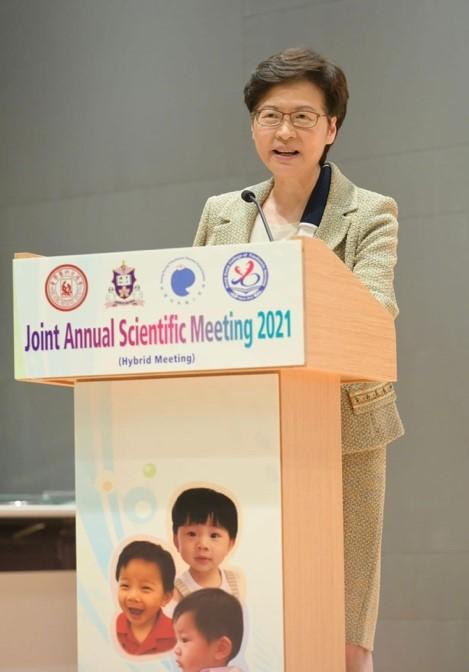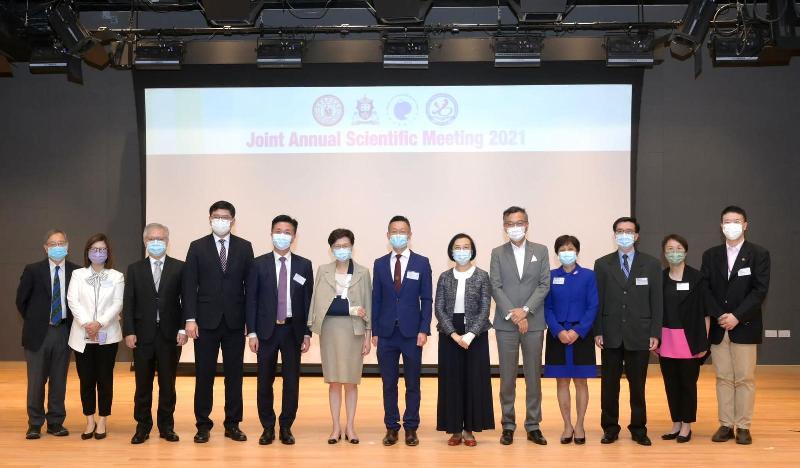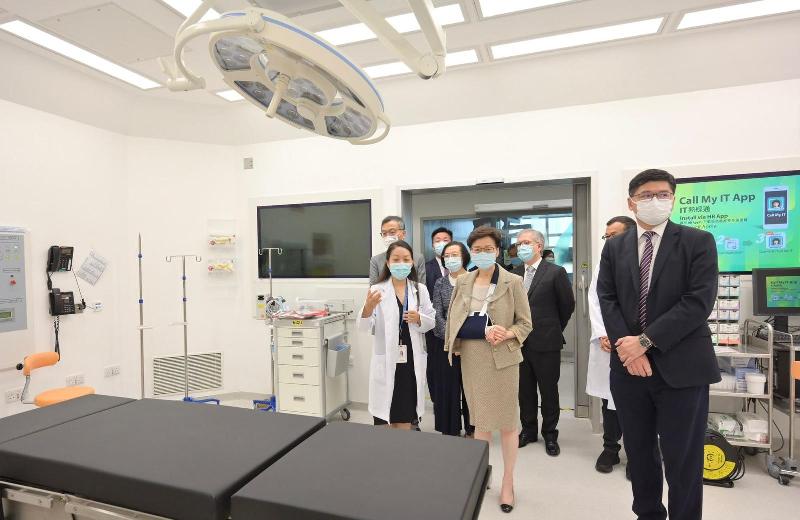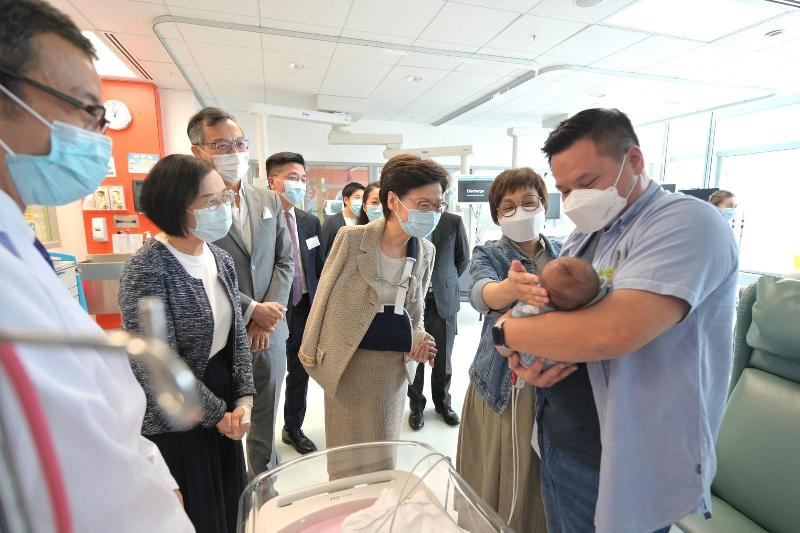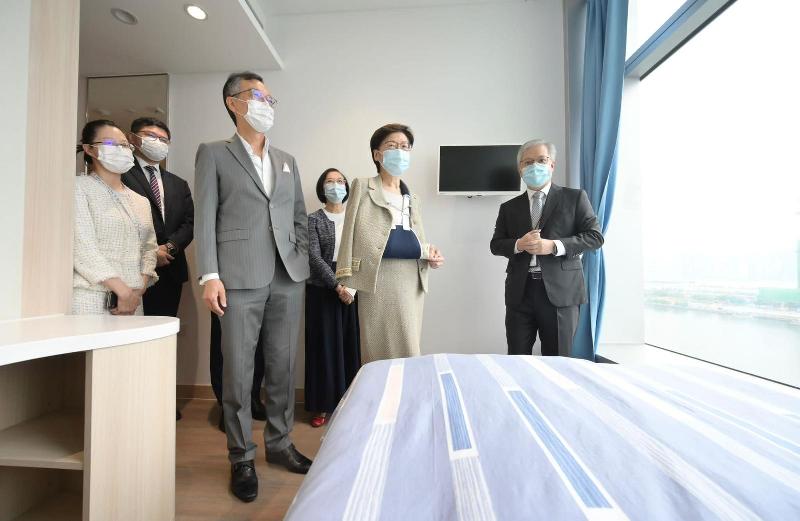​Following is the speech by the Chief Executive, Mrs Carrie Lam, at the opening ceremony of the Joint Annual Scientific Meeting 2021 "Challenges in Child Health in Post-Pandemic Era" today (October 30):
Distinguished guests, ladies and gentlemen, those who are present here and online,
It gives me great pleasure to join you all here at the fifth joint annual scientific meeting co-organised by four associations in Hong Kong. They are the Hong Kong Paediatric Society, the Hong Kong College of Paediatricians, the Hong Kong Paediatric Nurses Association and the Hong Kong College of Paediatric Nursing. Since the opening of this children's hospital, I understand that this annual event has been taking place, and rightly so, in the Hong Kong Children's Hospital.
Based on the original programme rundown given to me, we were supposed to have three official speakers: myself, the Secretary for Food and Health, and Dr CC Lam (Non-official Member of the Executive Council, Dr Lam Ching-choi). I asked Dr CC Lam, "why did you want to address a paediatrics event?" He said, "I am a paediatrician!" Because for a very long time, I have been cooperating and learning from CC on the elderly side, I thought he is a geriatric doctor. I did suggest to the organising committee that instead of the three of us speaking on separate subjects concerning the well-being of our children, because looking after the well-being of children requires cross-bureau, cross-policy, cross-professional support and hence since the Chief Executive of the Hong Kong SAR has been invited to this joint meeting, let me do the job on behalf of the three of us.
There is an African proverb which we are very familiar with: it takes a village to raise a child. I think the message is clear in those ancient times, but also in our modern times, or even more so. Hong Kong has been very fortunate, thanks to the foresight of the earlier generations of our health officials, including some whom I have worked with in the 1980s when I joined the service as an Administrative Officer. Thanks to their inspiration and foresight, Hong Kong has actually a pretty good network looking after maternal and child health of the population. And through this very extensive network of maternal and child health centres – there are now totally 31 of them under the Department of Health – and with the high quality and very affordable and almost universally accessible public hospital services, Hong Kong is very proud to have one of the world's lowest infant mortality rate and maternal mortality rate. It's a pity that our birth rate is also one of the lowest. We need to do much better in encouraging our women to raise a child, because it is such a pleasure to see a child grow up.
With those significant achievements in protecting the health of a child, we shouldn't stop there. Over the years, with the sophistication in medical technology and the specialisation of medical and nursing professionals, I have seen first-hand how these professionals simply would not give up the precious life of any single child. I visited the neonatal ICU (intensive care unit) when I gave birth to my first child and also, from time to time, as a public official. I really have to commend and salute these medical and health, nursing and allied health professionals for taking such good care of our newborns.
While we want our children to be born healthy, inevitably some will be born with complications. It is one of our jobs to prevent, as far as possible, these genetic diseases and to look after children who are born with complications. That's one of the key missions of the establishment of the Hong Kong Children's Hospital. I am pleased that medical professionals and, especially, the management of the Hospital Authority have been making great use of this facility, not only in terms of providing care, but also in terms of research and development.
Since I took office some four years and three months ago, I have made "pro-child" one of my philosophies in social policy: pro-child, pro-family, pro-work and pro-user. Over these four years or so, I have tried to put into practice this pro-child conviction in some of our policies, not necessarily just in medical and health, but also in education policies. Just give you a few examples of the key measures that we have been taking under this conviction to serve the interest of children first and foremost. One is to provide quality pre-school education for children. I am sure you are aware that while we have compulsory and free education, it did not include pre-school, that is child care education at kindergartens or kindergarten-cum-child care centres. But in this term of Government, through a kindergarten subsidy scheme, we are now providing a universal and free education for pre-schoolers. Ninety per cent of the half-day kindergarten education in Hong Kong is now free of charge. In other words, parents do not need to pay a single dollar for putting their kids aged two to six in kindergartens or kindergarten-cum-child care centres in Hong Kong. And to ensure that ethnic minority pre-schoolers would also have the chance to benefit from pre-school education, especially in learning the Chinese language, we are providing extra subsidies for kindergartens that are prepared and happy to enrol ethnic minority kids in their kindergartens.
The second measure, which is very close to my heart because I developed this pilot scheme when I was the Chief Secretary for Administration in late 2015, is the pilot On-site Pre-school Rehabilitation Services (OPRS). It was introduced in late 2015 as a pilot, funded by the Lotteries Fund, but has since being regularised in 2018 in this term of Government; and with the number of places significantly increased from about 3 000 during the pilot period to 9 000 this year, and it will further increase to 10 000 in the next school year in order to fulfil my pledge made in 2018 – it will be zero-waiting time for pre-schoolers who need rehabilitation services. I will come back to OPRS later on because I think we have so much to learn from this programme, especially for medical and welfare collaboration.
The third measure is, in order to make full use of the OPRS and other forms of pre-school rehabilitation services, we need child care assessment. Paediatricians, especially those trained in child assessment, have to first have the opportunity to evaluate and assess the special needs, the disabilities and developmental delays, especially in speech, of these kids. In the last three to four years, we have been expanding the Department of Health's Child Assessment Service (CAS), and a new Child Assessment Centre is being planned. Meanwhile, we have set up an interim Child Assessment Centre in order to cope with the demand. On this score, I have to commend the Department of Health's Child Assessment Service team for speeding up the completion of new cases within a pledge of six months, from achieving only about 49 per cent in 2018 to reaching 65 per cent last year, and this was done despite the chronic staff shortages in the CAS of the Department of Health. That chronic shortage still stands at 40 per cent of the medical staff. Of the establishment of 25 medical staff in the CAS, I now have 10 vacancies. You can understand my passion and my commitment to introduce the legislation to bring in non-locally trained doctors. If we could bring in 10 paediatricians tomorrow, our kids will not have to wait so long for the child assessment service, and we will be able to immediately match the OPRS and other forms of pre-school rehabilitation services for these kids. And you know better than I do what early intervention means in medical and health services. I hope for those who are still skeptical about the non-locally trained doctors legislation, they can be convinced by this little example of how we can enhance our medical staff provision to benefit the people of Hong Kong.
The fourth measure, is to set up a high-level Commission on Children chaired by my deputy, the Chief Secretary for Administration. It comprises both officials at very senior levels and also people outside of the Government who are passionate about the well-being of children.
In order to support the work of the Children's Commission, the fifth measure is, I have injected more funds into the Child Development Fund in order to finance projects which will promote the well-being of the children, particularly in terms of public education.
The sixth measure is to expand the child care service places, ranging from after-school care to mutual help support in order to relieve the burden of working mothers. Hong Kong's women labour participation rate is not high. Despite the provision of almost 400 000 foreign domestic helpers, our women labour participation rate is just about 50 per cent, which is lower than Singapore and far lower than Japan actually. In order to encourage more women, well-educated women – including many medical doctors who now account for over half of the first-year first-degree medical students in the two universities – in order to help them, to retain them in the labour force, we need better child care support. What I have been talking about would be for the more grassroots and low-skilled mothers because I'm sure for high-skilled mothers, you can look after yourselves, but let me appeal to you that apart from getting a foreign domestic helper to look after the kids, the time to be spent by the parents, especially the mother with their children, is of paramount importance. I have this first-hand experience in raising my two sons. I am going to run a campaign soon to encourage employers, both in public and private sectors, to offer flexible employment to working mothers, maybe three days a week, maybe by sessions or by working at home and things like that, so that together we could retain the well-educated and professional women in Hong Kong in our workforce but at the same time, we respect the choice of the mother to stay as long as possible with their children.
The seventh measure is, some kids do have problems, and the best place to discover these problems will be where they are educated. We have school social workers in primary and secondary schools, but we didn't have that, in those days, in a kindergarten. A pilot scheme was launched on providing social work service at the pre-school institutions including the kindergartens.
And finally, just a week ago, we passed a piece of legislation to ban e-cigarette altogether, which will benefit the health of our kids.
I said I would come back to OPRS because this is such a worthwhile experience that I want to share with the members of the medical and nursing fraternity. As I recapped, the OPRS was introduced as a pilot in late 2015. It was not conceived by the Government – as usual, bureaucrats are too slow in innovating for new ideas – it was based on a self-funded scheme run by one or two NGOs. I don't want to name them because now everybody is doing OPRS, but they were the pioneers in introducing this OPRS which stresses on being "on-site". In other words, the professionals are not asking the children to go to their centres, but they are reaching out to where the kids are. The kids are in the kindergartens because they are pre-schoolers. It is an on-site, outreaching form of pre-school rehabilitation services.
It was hugely effective. I have rarely seen a government scheme that is so popular amongst everybody. It is very popular amongst the parents, first of all. Parents find this scheme highly effective. I have interviews with at least half a dozen of parents who have received the service of OPRS for their kids, and everyone of them was so gratified and so happy to see their children improving in their daily life, improving in communicating with their parents and responding to what the parents want to communicate with them. It was highly effective and hence, in this term of Government, we put this service on a regular platform from the 2018/19 school year. And in the last three years, we gradually increased the number of places, as I said, from 3 000 to 6 000, to 8 000 and this year, to 9 000. We have already allocated money for doing 10 000 places in the next school year, that is 2022/23.
It was also very popular, surprisingly, among different professionals. Sometimes, when we introduce a new service, one profession is very happy and the other profession is not quite happy. But this is a service that is welcomed by the multi-disciplinary team, whether on medical, educational, as well as social welfare.
We are not introducing this scheme as a cheaper alternative to other forms of pre-school rehabilitation. Some of you would be familiar with, before the introduction of the OPRS, we have what we called the Special Child Care Service, we have what we called the Integrated Programme (IP) places at normal kindergartens, and we have the Early Education and Training Centres (EETC). The OPRS is not inexpensive at all. The unit cost per place per month of the OPRS is about $9,000, which is 20 per cent more than the two forms of the services that I have just mentioned. The unit cost for an IP place and the unit cost for an EETC place is 20 per cent less than the unit cost of an OPRS place.
We have seen that 99 per cent of recipients of the OPRS have gone onto mainstream Primary One. They no longer need any special education, they go into the mainstream Primary One and follow-up evaluation shows us that they are also adjusting quite well. They would need a little bit of transitional support and that's why the OPRS data is now transferrable to the education data so that the schools that admit the OPRS children will know their background, their training and their adjustments and so on and so forth. Ninety-nine per cent, almost 100 per cent of them went on to mainstream schools.
And also from the parents' perspective: last year, we did a survey to ask parents who have kids wait-listing for the Special Child Care Centres (SCCC) service, and 80 per cent of these wait-listed parents preferred to stay with OPRS. They said they would no longer want to waitlist their child for SCCC, because somehow the SCCC carries a little bit of stigmatisation. They would rather stay in a normal kindergarten with OPRS and then move on to a mainstream school for Primary One. That is the satisfaction and the effectiveness of the OPRS.
I have been following this programme for years. I have asked for evaluations to be done by the Education Bureau and the Social Welfare Department together with the universities. We together concluded that there are these five success factors for the OPRS which I hope would provide some inspiration for the medical, nursing and education sectors to consider how we can look after not only the children, but also the elderly which CC and I are very concerned with.
The first success factor is a multi-disciplinary team. Of course, this multi-disciplinary approach starts within the Government. This service was conceived and developed with the collaboration among three bureaux: the Education Bureau, because they are responsible for the kindergartens; the Food and Health Bureau (FHB), because they are responsible for child assessment and curative care; and finally the payment, the funding came from the Social Welfare Department under the Labour and Welfare Bureau, because if we don't have the OPRS, the Social Welfare Department will still have to look after all these wait-listed children with special education needs. That cross-discipline collaboration within the Government and outside the Government has contributed to the success of the OPRS. If you now look at the make-up or the composition of the OPRS team, it has different disciplines there, some even have educational psychologists on top of clinical psychologists, speech therapists, occupational therapists, physiotherapists, child care welfare workers and you name it.
The second success factor is a tripartite collaboration. The first factor is professional collaboration. The second factor is tripartite collaboration. These three parties are: one, the school. If the school is not receptive, then it is very difficult to operate the OPRS. Now I have 860 kindergartens and kindergarten-cum-child care centres running the OPRS. The school is a very important stakeholder in OPRS. The second party is home, because through OPRS, the multi-disciplinary team is also training the parents: if you go home, please observe your kid on whether they could walk a straight line, whether they would respond to your questions and so on, and they provide toys and kits and all the other things for them to take home to continue the training at home. And finally is the community. You have not heard any bad words about this programme, even when at the moment I still have a little bit of a waiting time of five months for OPRS because the matching takes time. There has been no complaint whatsoever from the service providers and the parents about the OPRS. Community support is also very important.
The third factor I have touched on briefly is about the family-focus approach. We said that we are not going to look after the kid for you, you have the responsibility as a parent to look after your kid but we are here to help you. You have to participate very actively in the whole programme. It is also the reason why we said while it is an outreach programme, an on-site programme, we also require EETC support. At certain intervals during a week or a month, the parent has to take the kid to the centre to learn even more about the muscular orientation and sensing and things like that, in order to instil in our parents the continued responsibility of the parent to help the child. In fact, during the process of expansion, some NGOs lobbied me to drop the EETC because it was very inconvenient to run the centre and the outreach service and they did not have enough venues. I said no, because you can adjust your timing, with your normal EETC taking place in the normal operating hours, and for the OPRS EETC, parents can come in the evening as long as you are willing, because we paid for it – the OPRS, as I have told you, costs $9,000 per unit per month. Sometimes you need to be very persistent on doing the right thing.
The fourth is a very children-oriented approach. We do not prescribe everything. I think under the OPRS model, we allow the practitioners to identify the most suitable intervention option for the child because each child differs from the other in terms of the services and support he needs. This is the best-for-the-child approach, which is also one of the reasons why the OPRS has been so effective and popular.
And finally, the effective communication amongst the various stakeholders and also the evidence-based evaluation. Throughout the last three to four years, we have been doing quite a lot of evaluation on the OPRS. Otherwise, I wouldn't have all these figures and indicators to share with you.
Looking after a child is a long journey. We will not stop at what we have achieved in the past. Looking ahead, I would use these four "more": we need to do these four things more.
First is more R&D. We really need more research and development. You have seen how Professor Dennis Lo's non-invasive DNA research has benefited millions of women all over the world, through improved detection of fetal abnormalities. And you know that we are pouring money into the Hong Kong Genome Project. All this R&D work aims at early detection in order to prevent a child from suffering, and the parents from that sorrow of seeing a child die from genetic diseases or rare diseases. We need to do more R&D and on this, I would encourage you to read the Policy Address this year on the innovation and technology paragraphs. We have committed to our very ambitious goal in turning Hong Kong into an international innovation and technology centre, particularly in life sciences. Looking around the Greater Bay Area, and even in the whole of China, I think what Hong Kong stands out, in terms of competitive advantages, is our life sciences, our medical research and so on, because we have two wonderful medical schools, we have a lot of very dedicated professionals in the public sector to continue to do this research. And I have announced that we would set up the InnoLife Healthtech Hub in the Lok Ma Chau Loop, which is the Hong Kong-Shenzhen Innovation and Technology Centre, to pool together all the expertise in life sciences in the universities, in the Health@InnoHK cluster now in Science Park, and in our state key laboratories supported by the Central Government. And we will bring in more expertise around the world through the Global STEM Professorship Scheme that we have launched in June this year.
And what's more on this area is that tech development is not just about basic research and R&D, it's also about translational and application. In the Northern Metropolis Development Strategy, we have found enough land beyond the 87 hectares in the Lok Ma Chau Loop to support advanced manufacturing. In case our R&D discoveries lead to new drugs, new vaccines, new medical diagnostic technology and devices, we could manufacture these things in Hong Kong. Of course, for mass production, we can go to the Greater Bay Area, but at least the prototyping, and the first of what we call the "one to ten" could be done in Hong Kong, because they need continuous adjustment. The research team and the production team need to interact very closely in order to devise the best product for the market. There is an additional 150 hectares of land in an area called San Tin which will be re-named as the San Tin Technopole to support R&D development in Hong Kong, let alone we still have Shenzhen across the Shenzhen River.
The second "more" is: let's put more attention to children's mental health. By and large, because kids are so precious these days, I would say that apart from those very disadvantaged who are still living in sub-divided flats who we will look after, most of the kids are being taken care of in terms of the materialistic things. But their mental health is quite inadequate. They are quite addicted to the social media and things like that. Their resilience has yet to be strengthened. This is an area that we could work together. Again, it requires cross-discipline and cross-sector collaboration to help our kids' mental health. We have a committee under the FHB to promote mental health, and they have been asked to do more on the children's mental health.
The third "more" is: somehow, in any society, there are people who would endanger the well-being of children, including the parents. We have some quite irresponsible parents. So the “more” here is, I would get more tough with these people who endanger the well-being of children. I have announced that we would consider two legislative items, one is the mandatory reporting of child abuse cases, and the second is to consider the Law Reform Commission's recommendation of introducing a new crime on causing or allowing the death of a child, basically through negligence.
The fourth is, I understand that we will be faced with more child issues as society evolves, as economy develops, as tech becomes more prevalent. Nobody could say that we have exhausted all the child issues or child problems. In order to be able to tackle more of these child issues or child challenges that come our way, I suggested in the Policy Address that we need a “child advocate” within the Government. The creation of a position called the Children Commissioner is very much on my agenda. I believe it doesn't need to be a policy secretary, it doesn't need to be a Permanent Secretary or a head of department, but it should be a suitably ranked official who has been given the mandate and the job to advocate for the rights and well-being of children. Never mind whether it falls under health, medical, welfare, education, leisure and culture, or sports and arts, but we need a Children Commissioner. This is an idea which I have floated, and I look forward to any feedback and support from the community at large.
All the things that I have said could not be done by the Government alone. We need the full support from everyone in society. I come back to that African proverb, that everyone of us has to put in our best in order to protect the well-being of children.
I wish you all a very rewarding meeting this year and thank you very much for your dedication over the years. Thank you.
Follow this news feed: East Asia






